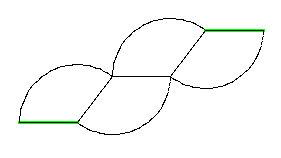
The Differential Geometry of the Sphericon
For references
on polyhedral curvature see Thomas Banchoff's early
research papers.
1. What is the Sphericon?
Ian Stewart's Mathematical Recreations
column in the October 1999 Scientific American
is entitled ``Cone with a Twist'' and describes the Sphericon,
a solid invented by C. J. Roberts of Baldock, England.
The Sphericon really is a (double) cone with a twist. It is
formed by taking two right-angled cones, joining them at the
base, slicing the resulting solid by a plane through the two
cone points, and gluing the two resulting pieces back together
after having rotated one 90 degrees with respect to the other.
It can be assembled out of cardboard (my favorite material is
overhead transparency sheets - they are flexible but resilient
and can be Xeroxed onto) by tracing and cutting out the following diagram.
Then attach one green side to the other.
This will bring the curved edges together
two by two, where they can be zipped together with tape.

Trace an enlarged version of this diagram onto stiff plastic
or paper, cut out and assemble by taping together the straight edges
(highlighted in green) and then
taping the curved edges together. This image was made
following directions in Ian Stewart's column. The pie-slices
have angle  or approximately 127.3 degrees.
or approximately 127.3 degrees.
|
In this column we will look at this surface as a mathematical
object and study its geometry. The tools for this study are
the same as those used for plane geometry: measurements of
lengths and angles. The difference from plane geometry is
that this surface is not smooth: it has corners and creases.
But we can keep track of the difference with our traditional
methods.
--Tony Phillips
SUNY at Stony Brook
© copyright 1999, American Mathematical Society.
 or approximately 127.3 degrees.
or approximately 127.3 degrees.
